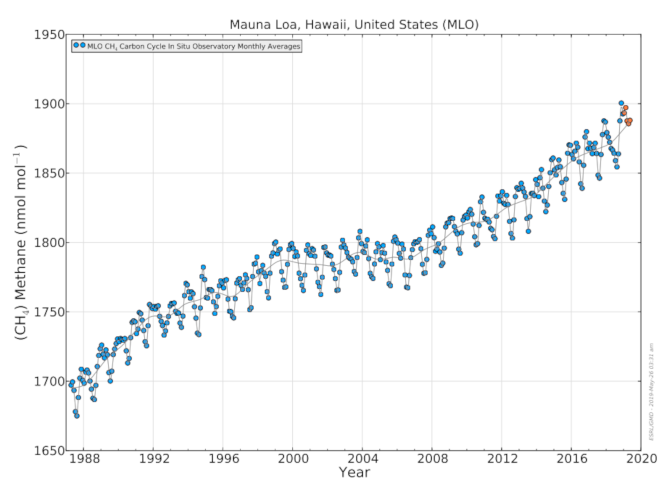Eliminating restrictions on damaging and dangerous methane pollution at oil and gas sites nationwide, as the U.S. Environmental Protection Agency (EPA) proposes to do, would be costly.
It was just this past Thursday that the current EPA proposed doing just that.
The Center for Biological Diversity (Center) in its “Trump Proposes Killing Methane Pollution Rule” press release of Aug. 29, 2019, speaks volumes.
“‘This reckless rollback pours fuel on the flames of a world on fire,’ said Kassie Siegel, director of the Center for Biological Diversity’s Climate Law Institute. ‘The EPA is now so determined to actually increase greenhouse pollution that it’s even shrugging off concerns from oil and gas companies about gutting these protections.’”
There are two proposal alternatives, according to the Center in the release.
“The first would scrap New Source Performance Standards for emissions of methane and other volatile organic compounds (VOCs) from oil and gas transmission and storage infrastructure and remove methane limits for oil and gas production and processing equipment.”
The second, meanwhile, where gas and oil equipment and infrastructure are concerned, as to restrictions on methane from, there would be … none.

The Center stated, “Methane is a climate pollutant that heats the atmosphere 87 times more than the same amount of carbon dioxide over a 20-year period.”
Methane, as a component of smog, “contributes to asthma and other public-health problems,” the Center explained.
Enforcement on parts of the Obama-era rule was suspended as imposed by Scott Pruitt in 2017, the former Environmental Protection Agency Administrator. “But the D.C. Circuit court struck that down, ruling the move was ‘unreasonable,’ ‘arbitrary’ and ‘capricious,’ and that the agency did not have authority under the Clean Air Act to block enforcement.
“‘Fracked gas is a climate killer, and it’s clear that simply reinstating the methane rule won’t be enough to stave off catastrophe,’ Siegel said. ‘The next president must commit to a rapid phaseout of all fossil fuel production and use.’”
It is apparent that time to get this right is running out.
Image above: NOAA
Published by Alan Kandel
More fear mongering with no scientific evidence that methane has any effect on ambient temperatures, just as CO@ has NO effect. Methane is about 0.004% of the atmosphere and dissapates very rapidly. Now how can a gas that is so dilute heat up the entire world? Come on folks……some common sense here.
The change in “climate” going back thousands of years has been eloquently explained by recent research showing it all relates to the earths proximity to the sun and changes on its axis and its rotational orbit that affect how close or far away the earth is from sunlight. Climate change has NOTHING to do with man, animals, volcanos, fossel fuels, etc.
In the “100-k year cycles, temperature swings and GHG rises: What does it all mean?” post (https://alankandel.scienceblog.com/2019/01/10/100k-year-cycles-temperature-swings-and-ghg-rises-what-does-it-all-mean) of Jan. 10th this year, incorporated into that is a graph showing “Vostok, Antarctica research station ice-core data.” The period of time charted covers from 420,000 years ago to today. Samples of ice were taken at various depths ranging from 0 to 3,300 meters.
There are five plots: carbon dioxide, methane, temperature, insolation and one other. If the temperature plot alone is looked at, what is evident is that Earth mean surface temperature reached its highest peaks at roughly 320-k, 220-k, 120-k and at about 10-k years ago. According to the graph, the mean surface temperature of the Earth has been pretty much steady state for the past 10,000 or so years.
Meanwhile, every time the temperature peaked during this time span, carbon dioxide and methane in the atmosphere did likewise suggesting a relationship or connection. The heating up of the atmosphere caused the increase in the air of both carbon dioxide and methane or the increase in the atmosphere of both carbon dioxide and methane led to the increase in global mean surface temperature. What other rational explanation could there be for this? Atmospheric warming, it appears, occurs much more abruptly compared to atmospheric cooling.
At no time in that 420,000-year span did carbon dioxide-in-air concentration ever exceed 300 parts per billion. This has occurred, on the other hand, in more modern times.
There is more than just planetary orbital forcing going on here. And, what would account for the relative stability of the average surface temperature of the Earth for the past approximate 10,000 years?
With orbital forcing being constant, one would expect the mean global surface temperature to retreat as it did approximately 120-k, 220-k and 320-k years ago after carbon dioxide and methane in the atmosphere reached their highest peaks, that is, based on the plots in the above-referenced graph.
Here is a more detailed explanation of why the SUN is the primary driver of ambient temperatures.
https://www.naturalnews.com/2019-08-30-nasa-admits-climate-change-not-caused-by-suvs-fossil-fuels.html?fbclid=IwAR2pKkUn5l809E5WITD9eS223akeJCkY4IqvkiQAJgkKSavIDr5MICkn9sM